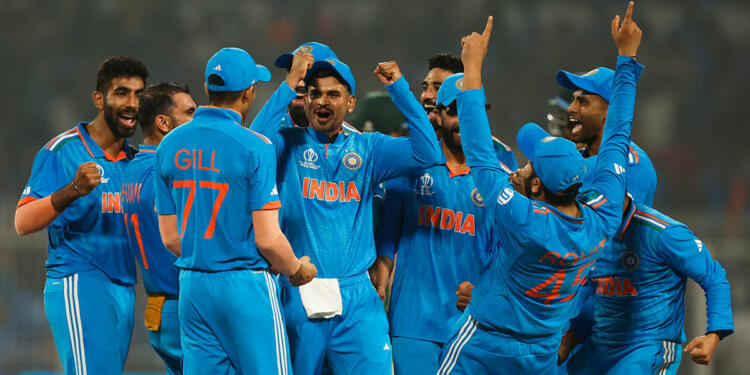As the World Cup league stage concluded on Sunday, India emerged as the only unbeaten team, a testament to their cricketing prowess. While New Zealand and Australia managed to briefly test the Men in Blue, a closer examination of the statistics reveals a clear and substantial gap between India and the other contenders in the tournament.
Let’s delve into a detailed statistical analysis, dissecting the first Powerplay (1-10 overs), the second Powerplay (11-40 overs), and the final Powerplay (41-50 overs) in both batting and bowling. To provide context, we’ll compare India’s performance with the combined average performance of the other three semi-finalists.
Batting Proficiency:
1. Dominance in the Powerplays:
- India’s initial 10 overs have been a stronghold, averaging an impressive 67 runs with the loss of 9 wickets collectively in the 9 games so far. This dominance, driven significantly by Rohit Sharma’s aggressive approach, sets the stage for their formidable batting display.
- In contrast, the contenders struggle in the Powerplay, managing an average of 57.33 runs, indicating a slower start and a less impactful foundation for their innings.
2. Middle Overs Strategy:
- The contenders lean towards an aggressive approach during the middle overs, resulting in higher run rates but at the expense of more wickets. India, however, employs a measured strategy, focusing on consistent strike rotation and patiently awaiting opportunities.
3. Navigating the Death Overs:
- The contenders, particularly South Africa, excel in the final 10 overs, accumulating an impressive 722 runs. India’s lower average in this phase is attributed to quick chases against Bangladesh and Australia, concluding the game in the 41.3rd over.
4. Tail-End Challenge:
- India’s middle-order strategy, seemingly influenced by the team’s long tail, affects their ability to sustain momentum from the Powerplay. In contrast, Australia and New Zealand benefit from the presence of impactful all-rounders, providing depth to their batting lineup.
Bowling Prowess:
1. Powerplay Mastery:
- India’s bowlers showcase excellence in all phases, particularly in the first 10 overs, where they claim 19 wickets with an economy of 4.3. The return of Jasprit Bumrah, while not reflected in the highest wicket tally, adds a psychological edge, with opponents seemingly content merely surviving his spell.
- South Africa, part of the contenders category, stands out in Powerplay wickets, outperforming Australia and New Zealand.
2. Middle Overs Control:
- Bowlers like Siraj, Shami, and spinners Yadav and Jadeja maintain relentless pressure in the middle overs, making it challenging for opponents to mount recoveries. This collective effort ensures sustained dominance throughout the innings.
- South Africa, within the contenders category, excels in Powerplay wickets, showcasing a noteworthy performance that surpasses both Australia and New Zealand.
3. Death Overs Mastery:
- Australia, despite Mitchell Starc’s lukewarm start, compensates with a formidable showing at the death overs, securing 24 wickets. This tally surpasses South Africa’s 15 and New Zealand’s 17, underscoring Australia’s resilience in closing out innings.
4. Bumrah’s Impact:
- The return of Jasprit Bumrah has made a monumental difference in India’s bowling department. While his wicket tally might not be the highest, his mere presence raises a metaphorical white flag from the opposition, highlighting the psychological advantage he brings to the team.
In conclusion, India’s World Cup dominance is not a result of a single facet but a comprehensive and balanced performance in both batting and bowling. The statistical narrative reveals a team that capitalizes on the initial 10 overs in both facets, setting the tone for success. While the contenders showcase strengths in specific areas, India’s consistency across all departments solidifies their status as the team to beat in the World Cup. With a depth of talent and strategic brilliance, the Men in Blue stand as formidable contenders as they progress into the semifinals.

































